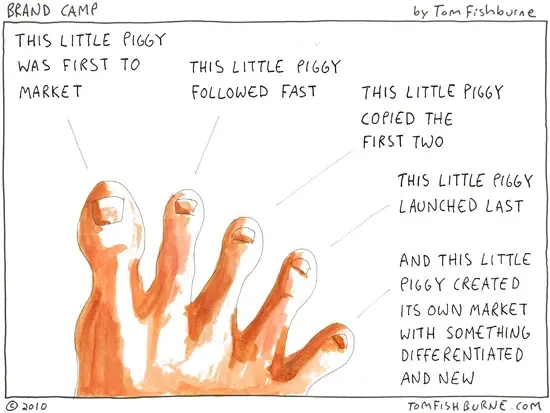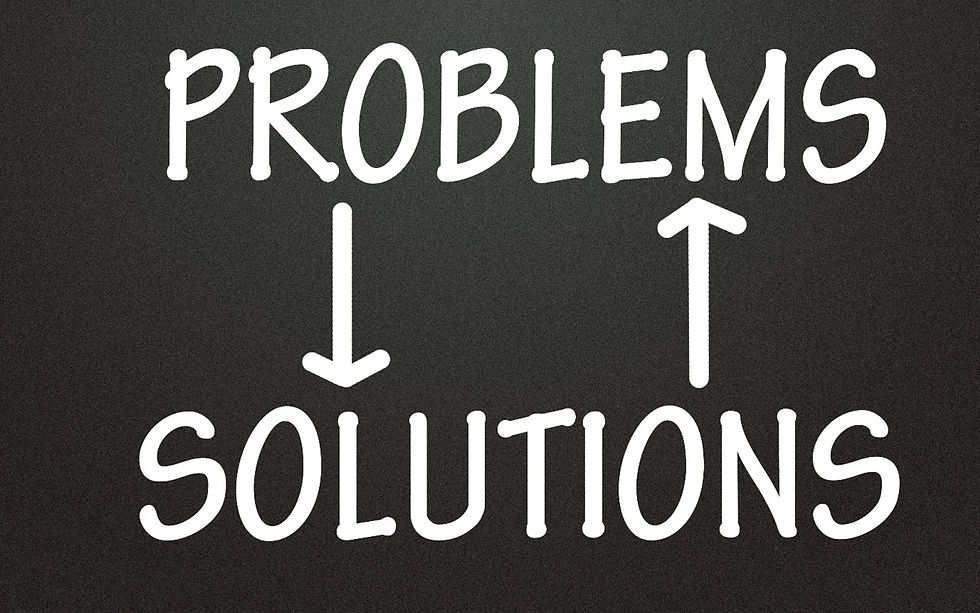Consistency meets Change: The New Brand Imperative
- Anne Ricci

- Aug 2
- 11 min read
Updated: Aug 3
How to maintain a consistent but relevant brand in turbulent times.

These are the four questions you should be asking your brand right now!
We've had it drilled into us. Strong, iconic brands are built over time using a relevant, enduring, and consistent brand promise, purpose, and personality that builds trust and loyalty among their consumers.
However, the world is changing rapidly, and your well-established, iconic brand may be losing its stronghold as your consumers' needs and problems evolve, or new start-ups and insurgent brands disrupt the status quo and redefine category rules.
Or you could be one of those previously insurgent brands that rewrote the rules when it launched and is now being challenged by a new set of brands that are breaking those rules all over again.
So how do you balance the absolute imperative to maintain strategic endurance and build a consistent brand, with the need to be agile in a world that is moving and changing so quickly?
By asking and answering four essential questions regularly!
1. How are your consumers' needs changing, and are you still relevant to them?
2. Who are your current competitors, and are you still distinctly different to or better than them?
3. What promise do you deliver to solve your consumer's current needs, better than your competitors?
4. What are your brand guardrails to maintain consistency but guide agile, informed decision-making?
--------------------------------------------------------------------------------
But first, let's set the context.
"The world is changing very fast. Big will not beat small anymore. It will be the fast beating the slow"
Brands must continuously evolve and adapt to keep pace in this rapidly changing world in which we compete. If you don't, you risk becoming irrelevant as consumers' needs change or being gazumped by new disruptive competitors.
We all know about the poster children for failure to recognise and adapt to change.
So, what is changing, and what do we need to do about it?
1. Consumers' needs have and will continue to evolve rapidly
As the world continues to be digitised, AI makes everything easier, and we have everything we need at our fingertips.

As issues such as climate change & sustainability are changing the way we live and consume
Or the general push to live a healthier, cleaner life is driving us to make better choices.
It is essential to identify the changes that directly impact purchasing and consumption behaviours within your category.
These changes may be driven by some of these macro trends above, or potentially, smaller micro changes, specific to your category.
2. New, agile competitors are disrupting every industry
Like consumers, the competitive landscape is constantly changing.
This cartoon from The Marketoonist beautifully summarises how insurgent, start-up brands are disrupting and resetting category norms and rules in even the most mature categories.

In today's digital world, the barriers to entry are low with easily accessible channels of communication, influence & commerce.
What may seem like a low-risk, niche brand one day can surge to become a major threat overnight.
With this significant increase in the sheer number of competitors, differentiating your brand solely on its product benefits is no longer an option.
These days, it's what you stand for and how you behave that sets you apart.
3. Despite more data than ever, actionable insights are becoming harder to find
We have more data than ever before. And we risk drowning in it because we don't know how to wrangle it into something meaningful.

But it is so important that we do mine the data because
Unique insights lead to unique strategy & ideas.
And to stay ahead, we need to find this new news before our competitors.
Unfortunately, most of the low-hanging fruit & all the obvious problems & insights have already been uncovered & solved for.
But new latent problems are waiting to be discovered.
We need to dig a little bit deeper to find new perspectives. This involves using new research methods and getting to the heart of our consumers to uncover that juicy new insight that, when unlocked, will change their behaviour in a way that is commercially beneficial to your brand.
Slow & Steady doesn't win the race anymore.

Yet, we've been told that strong brands are built over time.
So how do we strike the right balance between long-term brand building & the need to be agile, adapt and move with speed?
By asking and answering these four questions
1. Check your brand relevance:
How are your consumers' needs changing, and are you still relevant to them?
Thanks to many powerful macro trends and technological advancements, consumers' needs, tensions, and preferences have evolved rapidly in recent times, so you may need to course-correct. It is crucial to identify the changes that are directly affecting the purchasing and consumption behaviour of your category and brand.
However, no matter how much our world changes, the fundamentals of marketing will remain the same forever.
Consumers have 'problems' Brands create solutions.

Consumer have needs, motivations and tensions that drive their purchase and consumption decisions.
It is our job as marketers to understand those needs, motivations and problems and build brands, products and service solutions to solve them.
The better the solution solves the problem, the more relevant a brand is perceived to be by consumers and the more loyal they become.
More than ever, Marketers need to dig much deeper to find these problems that their brand can solve for
As we have identified above, consumers' needs are changing rapidly. Therefore, it is crucial to identify the changes that directly impact the purchasing and consumption behaviour of your category and the expectations consumers have of your brand.
You should not only seek to uncover the new or emerging problems that are more visible on the surface, but also the latent ones that lie beneath the surface. Ones that consumers may not even know they have yet. This is where you unlock the magic.
Identifying these changes before your competitors do and possibly even before your own consumers realise it, is where you will find your competitive, first-mover advantage and the chance to drive transformational growth.
But you must do it in a way that respects your brand's foundations and heritage. It must be a pivot or an evolution, not a complete U-turn!
Berocca is an excellent example of a brand that has evolved to be relevant in today's busy world.
The original 'hangover' recovery cure that gave you back your B-B-Bounce, Berocca, was challenged by the energy drink market, which, with their high caffeine levels, does a much better job getting us feeling some sense of normal after a long, late night.
However, as our lives became busier and more stressful, so did the emerging need for sustenance to get us through a typical day, even if we were asleep by 9:30 pm the night before.
Berocca seized this new opportunity and repositioned itself with the slogan "Big Days Start with Berocca."
With its sustained energy boost thanks to the long-standing vitamins & minerals claims, this was a much more distinctive and credible strategy for Berocca compared to the fleeting boost an energy drink provides. Additionally, this need (hopefully) occurs much more frequently than the dreaded hangover, making it a commercially sound evolution.
To find the problems, you need to dive the insight iceberg
Uncovering these changing, latent or new needs is quite the art. They do not simply fall in your lap. They involve a lot of work.

Firstly, you need a thorough understanding of your consumer and what they are currently thinking, doing, and needing, gained through data mining, research, observation, and some good old-fashioned intuition.
Then you need to dig deeper and ask 'why' to go beyond surface-level behaviours and attitudes and get to the underlying causes of what drives them.
Only then will you find those motivations and tensions that will deliver breakthrough and game-changing growth in today's world.
Those motivations or tensions that, when unlocked by your solution, will change your consumers' behaviour in a way that is commercially beneficial to your brand.
2. Check your brand's uniqueness:
Who are your current competitors & are you still distinctly different to or better than them?
As I mentioned earlier, insurgent brands are disrupting and resetting the rules in even the most mature categories. A recent McKinsey study found that the top 25 manufacturers are responsible for 59 per cent of sales but only 2 per cent of category growth. Conversely, 44 per cent of category growth has come from the following 400 manufacturers. The small guys!
Continuously monitoring your competitive framework and understanding the drivers of growth for even the smallest competitors is critical.
Because with the ability to communicate & sell at scale online, what may seem a low-risk, niche brand one day can surge to become a major global threat overnight, either copying your success formula and selling at a cheaper price or completely rewriting the rules you have played by for years.
Finding ways to either pre-empt and block this disruption or pivot to a more ownable (and relevant) proposition needs to happen quickly but strategically.
These insurgent brands are intensifying competition and eroding your point of difference. You must find new ways to stand out.
Unfortunately, standing out and retaining your uniqueness is becoming increasingly difficult, especially in mature markets, where a product or service's point of difference is becoming harder to find and/or maintain.
The successful brands are the ones that build and focus on more ownable emotional benefits, brand personality, and distinctive assets to stand out and build preference.
Booking.com is an example of a brand that differentiated on emotion and personality as the competitive intensity of the online travel market grew, and due to a lack of meaningful differentiation, price became the default choice driver. Booking.com looked beyond the functional, cheapest-price positioning and tapped into the emotional tension of how the right hotel room choice can make or break your long-awaited holiday, with a very distinctive personality & tone of voice.
How do you find your meaningful & distinctive place in the market?
Step 1: Define your competitor set, based on the needs and problems you are solving for your consumer.
Ask yourself, who does your brand compete with as it solves your consumer problems?
Look beyond your direct substitute competitors to your indirect & adjacent competitors and identify who else could be solving the same problems, occasions, needs or emotional benefits.
Looking at this broader competitive set often reveals a new set of potential insights & POD.
When Swatch Watch looked beyond competing with other watches to jewellery and wrist accessories, it helped redefine the brand to today's highly aesthetic and interchangeable product range.

Step 2: Identify your points of parity and points of difference
Once you identify your broader competitive set and the new sandpit you are playing in, the next step is to complete a competitive comparison to understand the points of parity you must have to compete and earn a seat at the 'consideration' table and the points of difference you have to leverage to earn the purchase and preference of your consumer.
This is where more brands are finding their functional points of difference to be quite empty, because their once-functional points of difference are now a category point of parity, as competitors have copied or exceeded them.
This means you need to identify the relevant and ownable emotional benefits, personality traits, and distinctive brand assets that will help you stand out and build preference.
By gaining that more profound understanding of your consumer, their needs, motivations and tensions in answering question 1, you'll know precisely the emotional benefits and solutions they are seeking.
Or you can build a relevant and ownable brand personality around key category drivers and points of parity. Aldi and KFC have both done an exceptional job in attaching such a personality to their category drivers of Value and Crave, respectively.
3. CHECK YOUR AUTHENTICITY AND CREDIBILITY:
What promise do you deliver to solve your consumer's current needs, better than your competitors? And is it believable and credible?
In answering questions 1 & 2, you may have found that your brand promise must evolve to meet the changing needs of your consumer or to combat or pivot against new competitive threats. As a result, you will need to revisit your brand promise and personality. You will need to ensure that your brand solves your consumers' problems better than your competitors.
To do this, the most obvious place to start is with your brand benefits. What are the functional, emotional and social benefits your brand offers? But more importantly, what are the attributes and reasons to believe these promises?
Although it may be deemed 'old school', the Brand Benefit Ladder ensures that any functional, emotional, or social benefits a brand promises are strongly linked to and backed up by solid reasons to believe and ownable brand attributes and assets.
This is where your brand history, heritage and consistency play an essential role.
By looking back into your brand's archives, you will find assets and equities that you have earned over time and are still relevant today. You should not let go of these proof points and trust-builders.
They may not be as unique or exciting, but they certainly give you the credibility to play in a more emotional or purposeful space.
Remember Berocca's vitamins & minerals. It was the proof point for Berocca to meaningfully move into a much more ownable and frequent need state.
Another way for a brand to build credibility is through its actions and behaviour. It's Brand Personality and Values.
If you think about it, a person's personality is a key indicator of their authenticity, and how consistently they display their true personality will determine how much we trust them. It is the same with brands. Defining and delivering a consistent, authentic brand personality will build credibility, trust and loyalty with your consumers.
4. CHECK YOU ARE STRATEGICALLY AGILE:
What are your brand guardrails to drive consistency but guide agile, informed decision-making?

Your freshly defined, relevant & distinctive brand will need to stay dynamic & flexible to compete in today's fast-paced world. So, you need to establish Brand Guardrails to spell out which elements of the brand positioning and the marketing mix are classified as SHOULD ALWAYS BE and should never change, what COULD BE if the situation called for it or SHOULD NEVER BE as it would damage the long-term equity?
Every day, someone in your business will need to make a decision that will affect how your brand is perceived in the marketplace. This decision-making needs to be fast, but it also needs to be informed to maintain brand consistency and stay on track towards its long-term goal.
Therefore, it is essential that you not only define your brand guardrails but also ensure that everyone involved in executing your brand positioning is fully informed and aligned. This may include cross-functional partners, such as the sales team, R&D, or external partners, like your agency village.
These guardrails may define strategically which categories your brand can or cannot enter, or which other brands you would or would never collaborate with. Tactically, it could be the tone of voice and humour in a social media post, or the price you are willing to drop to before devaluing your brand position in the market.
These guardrails ensure that when you need to make fast, tactical decisions to remain agile, you make rational, strategically sound decisions with your head, not your heart.
Even the mega master brand Virgin has made the mistake of stretching beyond its brand guardrails - into a category or industry that didn't need disruption, and a "better deal" that the Virgin brand is renowned for.
They launched Virgin Brides and failed because it was not a category that needed disrupting with a better deal.
And their launch into the Cola market spectacularly failed because they didn't deliver a substantially better product than the competitors.
Richard himself admits these decisions were ill-informed and made on a whim.
A good set of guardrails would prevent "heart" decisions like this from being made.
It's tough to balance your brand's strategic endurance and its consistent, recognisable and trusted assets with the need to be agile.
But it can be achieved by asking the four essential questions regularly.
1. How are your consumers' needs changing, and are you still relevant to them?
2. Who are your current competitors, and are you still distinctly different to or better than them?
3. What promise do you deliver to solve your consumer's current needs, better than your competitors? And is it credible & authentic?
4. What are your brand guardrails to guide agile, fast decision-making?
It's about SHARPENING your brand positioning, not sawing it
If you'd feel like you might need to answer these questions and sharpen your brand positioning, I'd certainly love to help you!
I can run a SHARPEN YOUR BRAND POSITIONING strategy workshop, where we will answer each key question using our signature tools and frameworks, and inspire you with case studies of brands who are 'doing it well'. You will leave with a clear action plan to sharpen your Brand Positioning and ensure your brand is maintaining what made it great while evolving to keep up in today's turbulent and fast-changing world.
I'd love to talk further. Please email me: anne@viamarca.com.au

Comments